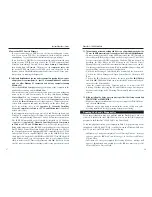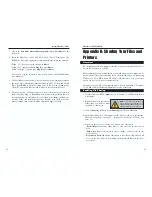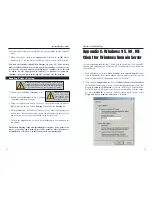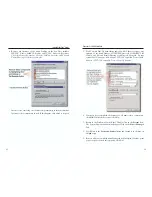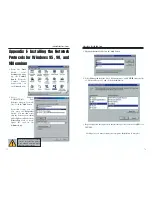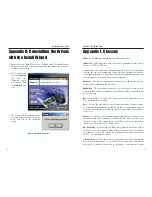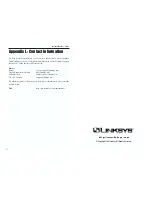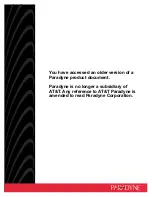
EtherFast
®
10/100 LAN Card
PCI provides "plug and play" capability, automatically configuring the PCI
cards at startup. When PCI is used with the ISA bus, the only thing that is gen-
erally required is to indicate in the CMOS memory which IRQs are already in
use by ISA cards. PCI takes care of the rest.
PCI allows IRQs to be shared, which helps to solve the problem of limited IRQs
available on a PC. For example, if there were only one IRQ left over after ISA
devices were given their required IRQs, all PCI devices could share it. In a PCI-
only machine, there cannot be insufficient IRQs, as all can be shared.
Ping
- (Packet INternet Groper) An Internet utility used to determine whether
a particular IP address is online. It is used to test and debug a network by send-
ing out a packet and waiting for a response.
Plug-and-Play
- The ability of a computer system to configure expansion
boards and other devices automatically without requiring the user to turn off
the system during installation.
Port
- A pathway into and out of the computer or a network device such as a
switch or router. For example, the serial and parallel ports on a personal com-
puter are external sockets for plugging in communications lines, modems and
printers.
Print Server
- A hardware device that enables a printer to be located anywhere
in the network.
RJ-11 (R
egistered
J
ack-
11)
- A telephone connector that holds up to six wires.
The RJ-11 is the common connector used to plug a telephone into a wall.
RJ-45 (R
egistered
J
ack-
45)
- A connector similar to a telephone connector that
holds up to eight wires, used for connecting Ethernet devices.
Router
- Protocol-dependent device that connects subnetworks together.
Routers are useful in breaking down a very large network into smaller subnet-
works; they introduce longer delays and typically have much lower throughput
rates than bridges.
Server
- Any computer whose function in a network is to provide user access
to files, printing, communications, and other services.
Software
- Instructions for the computer. A series of instructions that performs
a particular task is called a "program." The two major categories of software are
82
81
Instant EtherFast
®
Series
sion layer (layer 5). NetBIOS can ride over NetBEUI, its native transport,
which is not routable, or over TCP/IP and IPX/SPX, which are routable proto-
cols.
NetBIOS computers are identified by a unique 15-character name, and
Windows machines (NetBIOS machines) periodically broadcast their names
over the network so that Network Neighborhood can catalog them. For TCP/IP
networks, NetBIOS names are turned into IP addresses via manual configura-
tion in an LMHOSTS file or a WINS server.
There are two NetBIOS modes. The Datagram mode is the fastest mode, but
does not guarantee delivery. It uses a self-contained packet with send and
receive name, usually limited to 512 bytes. If the recipient device is not listen-
ing for messages, the datagram is lost. The Session mode establishes a connec-
tion until broken. It guarantees delivery of messages up to 64KB long.
Network
- A system that transmits any combination of voice, video and/or data
between users.
NIC
(
N
etwork
I
nterface
C
ard) - A board installed in a computer system, usu-
ally a PC, to provide network communication capabilities to and from that com-
puter system. Also called an adapter.
Node
- A network junction or connection point, typically a computer or work
station.
Notebook (PC)
- A notebook computer is a battery-powered personal comput-
er generally smaller than a briefcase that can easily be transported and conve-
niently used in temporary spaces such as on airplanes, in libraries, temporary
offices, and at meetings. A notebook computer, sometimes called a laptop com-
puter, typically weighs less than five pounds and is three inches or less in thick-
ness.
Packet
- A unit of data routed between an origin and a destination in a network.
PCI
(
P
eripheral
C
omponent
I
nterconnect) - A peripheral bus commonly used
in PCs, Macintoshes and workstations. It was designed primarily by Intel and
first appeared on PCs in late 1993. PCI provides a high-speed data path
between the CPU and peripheral devices (video, disk, network, etc.). There are
typically three or four PCI slots on the motherboard. In a Pentium PC, there is
generally a mix of PCI and ISA slots or PCI and EISA slots. Early on, the PCI
bus was known as a "local bus."



